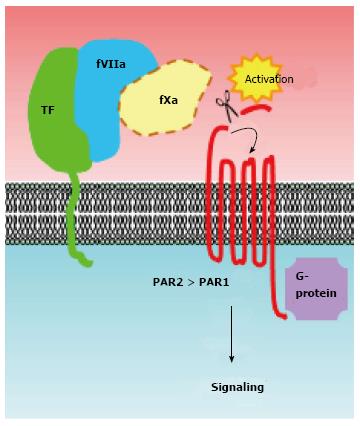Copyright
©2014 Baishideng Publishing Group Inc.
World J Clin Oncol. Dec 10, 2014; 5(5): 908-920
Published online Dec 10, 2014. doi: 10.5306/wjco.v5.i5.908
Published online Dec 10, 2014. doi: 10.5306/wjco.v5.i5.908
Figure 2 Activation of protease-activated receptors is a major mechanism of tissue factor-coagulation factor VIIa signaling in breast cancer cells.
The proteolytic activities of the TF-fVIIa binary complex [potentially (designated as dotted line) ternary complex with fXa] cleave the N-terminal end of PARs. PARs are then activated via intra-molecular binding between the newly created N-terminus and an extracellular loop region of the receptors. Activation of these G-protein-coupled receptors subsequently activates downstream signaling cascades. A number of studies have indicated that PAR2 is crucial for activation of a TF-fVII-driven signaling cascade in breast cancer cells. The role of TF-fVII on PAR1 signaling in breast cancer cells is less evident. FVII: Coagulation factor VII; TF: Tissue factor; PARs: Protease-activated receptors.
- Citation: Koizume S, Miyagi Y. Breast cancer phenotypes regulated by tissue factor-factor VII pathway: Possible therapeutic targets. World J Clin Oncol 2014; 5(5): 908-920
- URL: https://www.wjgnet.com/2218-4333/full/v5/i5/908.htm
- DOI: https://dx.doi.org/10.5306/wjco.v5.i5.908









